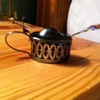Posted 14 years ago
 covers
covers
(32 items)
Dr. John Parsons was a multi-talented medical doctor from Quincy, Illinois, who ventured west to Colorado Territory in 1859. Parsons, who also was a botanist and a hard-rock miner, had a strong background in metallurgy. In the summer of 1860, he moved to the Tarryall Mining district in South Park, where he assayed gold ore for placer miners.
In 1861, after securing dies and equipment, Parsons returned to Tarryall, this time with a coin press mounted in the back of a wagon. In that summer, the towns of Hamilton and Tarryall were home to more than 6,000 miners. Parsons located his minting wagon at the mouth of Tarryall Creek, just west of the two towns.
It is reported that Parsons charge a fee as high as 20% to the miners wishing to convert their gold dust to coin. Thus a miner would receive a $5.00 coin in exchange for $6.25 of gold dust. Parsons left Tarryall before October 1861 and moved to Denver where he became active in several projects, notably a water-ditch company.
The obverse of the Parsons $2.50 and $5 gold piece shows a six-stamp, quartz reduction mill. Basically, this machine pulverized ore to aid in the extraction of the gold. The device portrayed is very similar to an actual example that was built in Buckskin Joe, a nearby town where Dr. Parsons owned a mining claim. That mill has been preserved and is shown.
However, the die engraver make a mistake in the spelling of Dr. Parsons name by leaving off the terminal "s" on the coins. Below the mill is the Spanish word "oro," meaning "gold." The coin's reverse shows an American eagle and shield, similar to federal coinage of the time. The words "Pikes Peak Gold" surround the eagle with the denomination below. Fewer than ten examples survive of the Parsons $2.50 coin.
According to contemporary reports, Parsons struck a "significant" number of $2.50 and $5.00 coins which circulated as far away as Denver. However, only four to six examples survive of the $5.00 denomination.
The obverse is on the $5.00 coin is similar to the $2.50 except that the first initial of Parsons name has been lengthened to "Jno." The reverse design is also similar but with the denomination changed to "Five D."
From the Mayer collection. Posted by Richard Frajola (from an article on my website)


















This is awesome! Especially great with the photo of the mill.
One question - was what Parsons did legal, given that the U.S. Mint took over the creation of official U.S. coinage in the 1790s? Was he just beyond the reach of the law or was he protected because he was in unincorporated territories rather than a state?
fyi, there's an interesting interview on U.S. "Colonial" coinage here:
http://www.collectorsweekly.com/articles/an-interview-with-colonial-coin-collector-ray-williams/
Potrero - Thanks - I will check out your link.
From my article on my website (http://www.rfrajola.com/mayergold/mayergold.htm#Dr.%20John%20Parsons):
"Prior to 1864, it was legal for private individuals to mint gold coins of their own design. Since the value of an individual coin was based upon its intrinsic value of precious metal, coins of accurate fineness and weight manufactured by private firms were usually accepted at full value. In fact, several privately-issued gold coins were more readily accepted in certain regions than were Federal currency.
Most issuances of private gold coins were made in association with discoveries of major gold deposits. Beginning with the unexpected finding of gold in Georgia and North Carolina in 1828, scores of private minters produced millions of dollars worth of gold coins in denominations ranging from a quarter dollar through $50 gold slugs.
The last gold mining region in the United States where it was still legal to mint pioneer gold coins was the Territory of Colorado, during the period 1860-1862."
For the record, in 1859-1860 the gold region near denver was part of Kansas Territory as Colorado Territory wasn't formed until February 28, 1861.
Potrero - Although I like the interview with Ray Williams on Colonial coins, these territorial coins are a whole different category. With a few Territorial gold coins having been posted, what Collectors Weekly needs now is an interview with a Territorial gold expert.